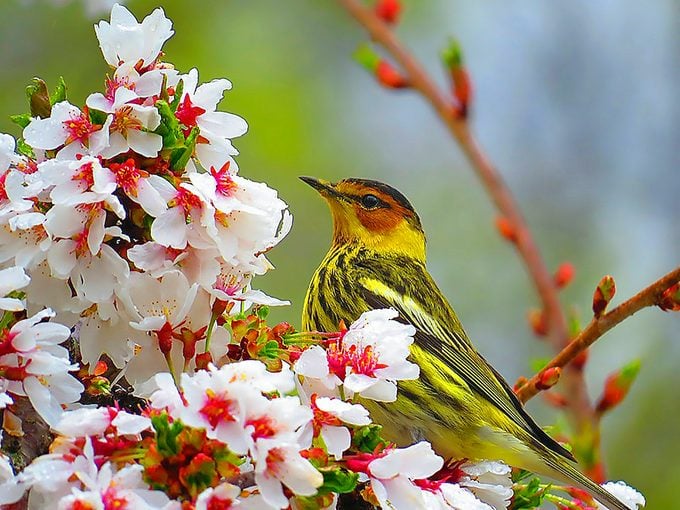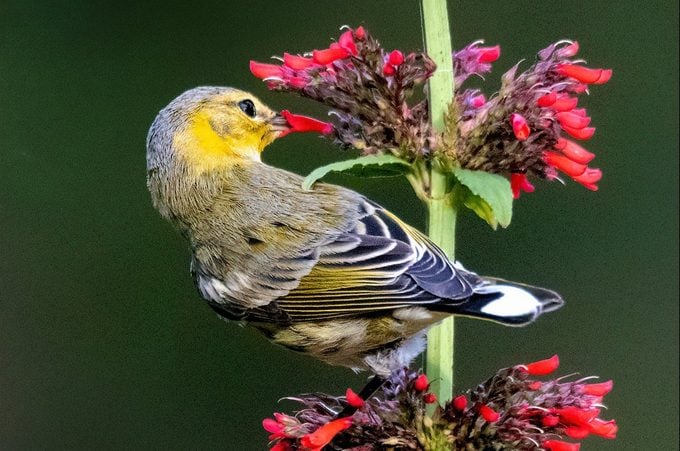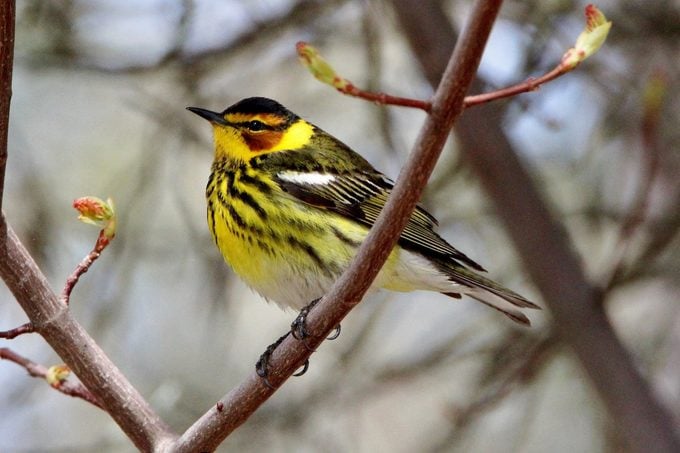How to Identify a Cape May Warbler
Updated: May 29, 2024
Learn all about the cheery Cape May warbler, including what the bird looks like and sounds like, and how to attract one to your yard.
On This Page
What Does a Cape May Warbler Look Like?

The male Cape May warbler is a bright sight after a long winter. His breast is brilliant yellow with black streaks, his wings are gray-brown with patches of yellow, and he has a gray-brown head with rusty patches and a black stripe across his eyes.
Females and immature birds appear similar, but they sport muted colors and lack the rusty feathers around the eye and cheek.
“They’re a nice, yellow warbler with black streaks on the chest, which is slightly unusual,” says Dr. Kevin McGowan, senior course developer for the Cornell Lab of Ornithology. “They have a big yellow wrap around their chin to the back of their head, but it encircles an orange face patch.”
Range: Do Cape May Warblers Migrate?

They certainly do — in fact, the species name comes from Cape May, New Jersey, a migratory bird hotspot. (Here’s how to be prepared for warbler migration season.)
Birding experts Kenn and Kimberly Kaufman say, “Most Cape May warblers spend the winter around the Caribbean; in spring they come back mainly through Florida, fanning out from there as they go north, with some going as far west as central Canada. They pass through in good numbers near the Great Lakes.”
It’s a lengthy journey for the little fliers: The trip from Ontario to Jamaica is 2,200 miles.
Kevin reiterates that Cape May warblers aren’t likely to spend significant time in most North American backyards. “You’re not going to see them in the summer,” he says. “They’ll pass through.”
Learn all about the protonothary warbler — a yellow bird that will live in your birdhouse.
Cape May Warbler Diet

If you’re in the United States, you’re more likely to see Cape May warblers passing through your yard during migration than sticking around for an entire season. But if you live within their range and would like to invite these small yellow birds to visit your yard, you might try appealing to their sweet tooth.

During migration, they might occasionally stop to eat fruit, including oranges (just like Baltimore orioles!). They also use their tongues to drink sugar water from hummingbird feeders and sip nectar from flowers.

A key component of the Cape May warbler’s breeding season diet, however, is insects, specifically spruce budworm caterpillars. Kevin explains that outbreaks of spruce budworms are directly correlated with increases in Cape May warbler populations, because more food during breeding season means that more of the birds can breed.
Nesting Habits

Once they reach their breeding grounds in Canada, these small birds nest in spruce or fir trees, which gives them access to their favorite caterpillar food source.
Nests are built from twigs, grass, pine needles and bark, and a typical clutch consists of four to nine eggs. Females incubate the eggs, but both parents feed the young.
Interestingly, the Cape May warbler builds its nest at a high altitude compared to other warblers, usually 40 to 50 feet off the ground.
What Do Cape May Warblers Sound Like?

Listen for the male’s song. It consists of three or more high-pitched tseet notes at the same pitch and volume, either sung singularly or doubled (tseet-tseet).
Bird sounds courtesy of the Cornell Lab of Ornithology
Next, meet the colorful and cute Canada warbler.
About the Expert
Lifelong birder and ornithologist Dr. Kevin McGowan is a senior course developer for the Cornell Lab of Ornithology’s Bird Academy. He earned a Ph.D in biology at the University of South Florida.
Sources
- Cornell Lab of Ornithology, “Cape May warbler: overview“




















